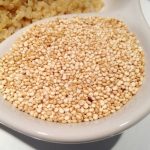Tuna is one of the viable sources of protein and we know protein is the most essential nutrient for canines. It’s also incredibly delicious, making it a nice substitute for meat. Is tuna a good addition to a dog’s diet? In today’s post, discover the effects of tuna in dogs and see if it’s something you can safely share, minus the worries.
Is Tuna Safe for Dogs?
There are presumptions that tuna is toxic to dogs because of its mercury content. Truth be told, the rich selenium in it helps keep it safe against any possible mercury contamination. Selenium is a mineral beneficial to pets as it is to humans. So yes, tuna, whether it’s canned or fresh, is still safe to feed a dog. The vets warn to exercise caution when giving anything new to your pet. In moderate amounts and if only given on occasion, tuna should be fine to offer to pets.
Many pet parents actually avoid giving their fur babies fresh and frozen tuna. This has something to do with the fact that the fresh variety has a higher concentration of mercury compared to canned tuna. According to the FDA’s list, fresh big-eye tuna contains 0.689 mean mercury concentrations (PPM), much higher than the mercury found in other types of fish like mackerel, marlin, and orange roughy. Canned tuna, also based on the FDA’s data, contains 0.126 mean mercury concentrations (PPM).
Is it okay to offer your dog salt-water fish, like tuna every day? The answer is a big NO. Over time, the small amounts of mercury found in tuna can build up inside a dog’s body. This is where the problem starts. It can cause chronic mercury poisoning that is pretty dangerous and can even lead to death. Mercury poisoning affects the nervous system by damaging its central part. It can be asymptomatic or will not show any signs at all. However, in extreme cases, it can make dogs feel sick with symptoms like bleeding, vomiting, and runny stool.
Ways to Serve Tuna to Dogs
Tuna is safe to eat straight from the can. Canning albacore or skipjack is a way of preserving it. You can add it to your dog’s rice meal, including the juice from the can. Many people give it to those pets suffering from an upset stomach. But if you want to cook it, below are three easy tuna recipes for dogs.
-Tuna Fudge Dog Treats
This doggie treat will take approximately 25 minutes to make. Plus, you can store this in the fridge if your pooch likes frozen treats. This one uses wheat flour, but if you don’t have it at home or if your pet is allergic to wheat, you can use white flour as a substitute. White flour does not have as much fiber as whole wheat flour, since much of it was already removed during processing. For these bite-sized goodies, you will need:
- 6 ounces of un-drained canned tuna
- 1 and ½ cups of whole wheat or white flour
- 1/8 teaspoon of garlic powder
- ¼ cup of parmesan cheese
- 2 beaten eggs
Directions:
- In a large bowl, combine all the ingredients. You may use a simple spatula but if you want to make mixing easier, use an electric mixer.
- Slightly grease your baking pan then spread the mixture on there.
- Cover the baking pan with foil then bake for 20 minutes at 350 degrees.
- Serve cooled or freeze if your dog likes frozen treats.
-Tuna with Egg
Does your dog love eggs? He will surely like this tuna recipe, which you can make tastier by adding eggs and healthier by putting in healthy oils like olive oil. For this recipe, you can use any type of cheese. If your pooch does not like the taste of cottage cheese, you can use cheddar cheese or feta if you prefer something that contains less fat and calories. Ground eggshells are a great source of protein and can be added to a dog’s kibble from time to time. To make tuna and egg, prepare:
- One can of drained tuna
- 2 large eggs
- ½ cup of cheese
- 1/8 teaspoon of ground eggshell
- 2 tbsp of olive oil
Directions:
- In a pan, heat the olive oil. Keep the heat low to avoid burning.
- Beat the eggs and cook them scrambled style.
- Add all the other ingredients.
- Allow the scrambled egg to cool thoroughly prior to serving.
-Tuna Loaf
This treat can be a great choice for dog training since it comes with nutritious ingredients and it’s so easy to make. This one uses garlic clove, which you can limit if you are hesitant to give garlic to your own pet. In small amounts, garlic should be fine to give to dogs. You can also use plain flour if you don’t feel like using wholemeal flour. This dish can be done in 10 minutes and only uses these ingredients:
- Tuna in oil (2 cans)
- 2 large eggs
- 160 grams of flour
- One garlic clove
Directions:
- In a large mixing bowl, add the tuna, eggs, and flour. You can also include the oil from the canned tuna.
- Crush the garlic clove and add it to the mixture.
- Mix all the ingredients with a spatula, until you get a thick paste consistency.
- Transfer on a microwave-safe plate then put on the microwave for around 5 minutes for each side.
- Allow to cool before slicing in bite-sized pieces and serving to your dog.
Important Reminders When Feeding Tuna
Some dogs are used to poultry-based proteins like turkey and chicken. If given tuna for the first time, they may show signs of stomach upset, like vomiting and diarrhea. Fish allergies in dogs can happen, but only on rare occasions. If you think your pet may be having this kind of allergy, seek advice from a veterinarian.
You may be thinking of adding tuna because of its protein content. Do note that while protein is very important for dogs, they still need a well-balanced diet consisting of other minerals, vitamins, and fatty acids. Also consider that there is a specific amount of protein dogs need depending on their age and lifestyle.
My Dog Just Ate Tuna: What Could Happen?
First, observe your dog for any possible adverse reaction, like diarrhea, vomiting, or constipation. If none of these occurred, then you’re good to go. However, if your dog showed signs of sickness and abdominal pain, discontinue feeding tuna and consult a vet for advice if the symptoms lasted for more than 24 hours. Your vet will likely ask you to bring a sample, especially if you just fed your pet canned tuna.
Check if the canned product is not expired or if the content was already spoiled. Unopened canned tuna usually last for five years from the date of manufacture. It should not have any unusual odor other than the fishy smell. While tuna comes with a naturally pungent smell, it should smell fresh and clean, and not rotten.
Benefits of Tuna for Dogs
It can be an additional source of protein. High-quality meat, like beef, lamb, and goat meat are the best sources of protein for dogs. But if you are looking for less expensive protein sources compared to these types of meat, consider fish-based proteins like tuna. An ounce serving of canned tuna can provide as much as 6 grams of protein per day. Based on the nutrition guideline for dogs, they should have a gram of protein for each pound of weight. For example, a dog weighing around 30 lbs. should also be given 30 grams of protein a day.
Tuna reduces the risks of heart disease. The omega-3 fatty acids in tuna also lower risks of heart disease. This type of oil keeps the heart healthy because it reduces the chances of blood clotting, it lowers blood pressure and it decreases triglycerides. This type of fat or lipid is stored in the fat cells and, in high levels, can cause seizures in dogs.
It protects the skin against infections. Tuna is an excellent source of omega-3 fatty acids, which is good for dogs suffering from skin problems since it can decrease inflammation. Aside from fighting against skin infections, omega-3 fatty acids are also good for the brain. The many benefits of omega-3 fatty acids are the reason why most canine supplements are rich in fish oil.
It helps boost the immune system. The zinc and selenium in tuna can help boost the immune system. A tin of tuna has 12.5 micrograms of selenium 1.27mg of zinc per portion. Selenium is a trace mineral known to prevent cancer in animals while zinc is beneficial for the proper function of the immune system.
Tuna promotes bone health. It contains Vitamin D, which is an essential part of the canine diet. As with people, our pets also need this vitamin for calcium regulation and phosphorous absorption. Without enough Vitamin D, dogs can become more susceptible to bone disorders like rickets and osteomalacia. While dogs don’t really need Vitamin D supplements, they should get it from their diet through food.
It’s a natural mood lifter. Did you know that tuna is one of the best mood-boosting foods? Thanks to its fatty acids, tuna is one of the foods you can share with your pet when you feel like lifting her spirits. The B-vitamins found in tuna helps in keeping the mood positive since it is good for the brain and it’s working directly with the nervous system.
It helps fight cancer cells. Fatty fish is one of the foods doctors recommend to fight cancer. Previous studies suggest that regular consumption of tuna helps eliminate the risk of breast cancer. In dogs, cancer may also appear in lumps and bumps, as well as wounds that do not seem to heal. The Vitamin D in tuna can also serve as the bones’ and teeth’s protection against many types of cancer.
Conclusion
Tuna can be safely given to dogs in moderate amounts and on occasion. You can use it as an ingredient for making homemade pet food. When prepared accordingly, tuna can be a beneficial part of a dog’s diet. Just avoid feeding it to a dog frequently, because of the traces of mercury that can be built inside the animal’s body. This can lead to chronic mercury poisoning which can be pretty serious and may cause death if left untreated.






















